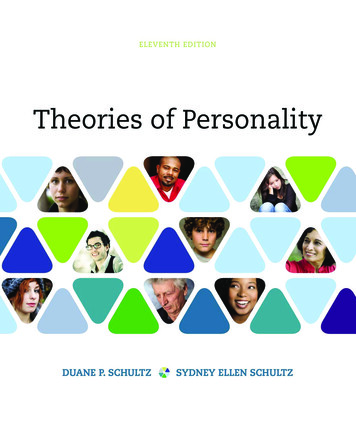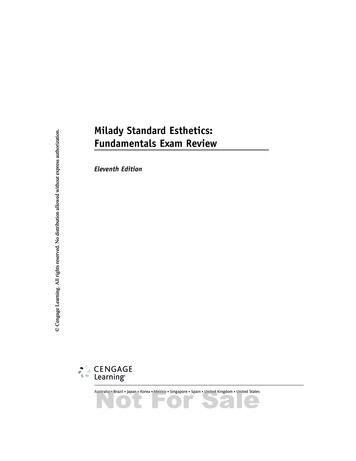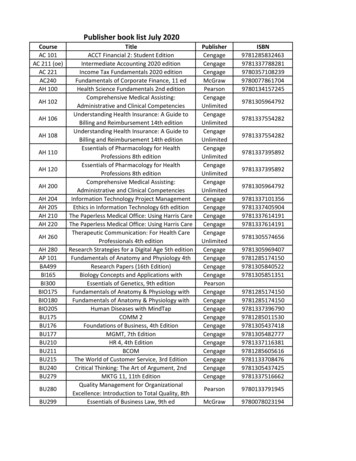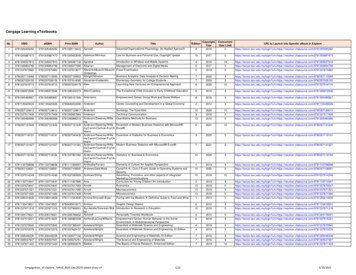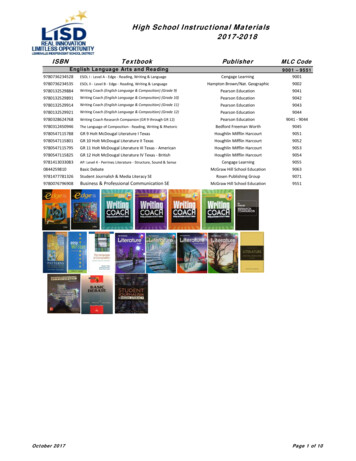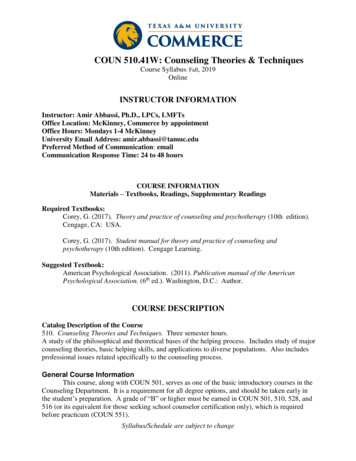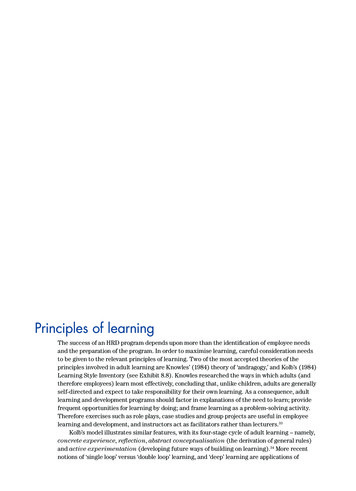
Transcription
286 Part 2: HRM strategies, systems and processesMeeting learning and development goalsTo help prove the effectiveness of learning and development, the evaluation phase mustaddress the validity of the associated program. Goldstein describes four approaches toprogram evaluation: learning program validity – whether employees have learnt something from the program transfer validity – whether knowledge or skills transfer has occurred back in the workplace intra-organisational validity – whether new and more experienced employees share similarperformance inter-organisational validity – whether a program validated in one organisation has similarresults in another organisation.31It may be argued that the second approach is the most relevant for most organisations, asdiscussed earlier in this chapter.Cost–benefit considerationsThe ability to measure the benefits derived from HRD varies according to the type of job. Whereemployees are performing relatively simple tasks, the effects of learning and development may showup quite dramatically. For more complex jobs, such as those at the managerial and professionallevels, the benefits are more difficult to measure. It is generally found, however, that the benefits willfar exceed the costs when the objectives to be met by an HRD program are clearly defined, when themost suitable instructional techniques are used and when employee motivation is high.The benefits that are experienced by an organisation are similar to those found througha carefully developed selection program. Increased productivity and the ability of thecompetent employees to assume more responsible roles in the organisation are the majorbenefits. Reduction of waste, accidents and similar problems may also result from HRDprograms.The argument which the HRD manager must sustain is that the employee developmentprogram led to such improvements. In many areas of training, learning and development, manyintangibles will arise that make measurement of results very difficult, although a number ofresearchers have addressed this key area.32Principles of learningThe success of an HRD program depends upon more than the identification of employee needsand the preparation of the program. In order to maximise learning, careful consideration needsto be given to the relevant principles of learning. Two of the most accepted theories of theprinciples involved in adult learning are Knowles’ (1984) theory of ‘andragogy,’ and Kolb’s (1984)Learning Style Inventory (see Exhibit 8.8). Knowles researched the ways in which adults (andtherefore employees) learn most effectively, concluding that, unlike children, adults are generallyself-directed and expect to take responsibility for their own learning. As a consequence, adultlearning and development programs should factor in explanations of the need to learn; providefrequent opportunities for learning by doing; and frame learning as a problem-solving activity.Therefore exercises such as role plays, case studies and group projects are useful in employeelearning and development, and instructors act as facilitators rather than lecturers.33Kolb’s model illustrates similar features, with its four-stage cycle of adult learning – namely,concrete experience, reflection, abstract conceptualisation (the derivation of general rules)and active experimentation (developing future ways of building on learning).34 More recentnotions of ‘single loop’ versus ‘double loop’ learning, and ‘deep’ learning are applications of
these theories to organisational learning, conceptualised best in Senge’s (1990) concept ofthe ‘learning organisation,’ or an organisation which systematically incorporates these adultlearning principles into its routine problem-solving and decision-making techniques in anongoing manner.35 These principles are illustrated in the following discussion.Exhibit 8.8 Kolb’s Learning Style ditions for learningTwo preconditions for learning will increase the success of those who are to participate in suchprograms: employee readiness and motivation. The condition known as employee readinessrefers to both maturational and experiential factors in the employee’s background. Prospectiveemployees should be screened to determine that they have the background knowledge orthe skills necessary for learning what will be presented to them. Recognition of individualdifferences in readiness is as important in HRD as it is in any other learning situation. It is oftendesirable to group individuals according to their capacity to learn, as determined by scores fromtests, or to provide a different or extended type of instruction for those who need it.The other precondition for learning is that the employee be properly motivated. That is, foroptimum learning the employee must recognise the need for acquiring new information or forhaving new skills; and a desire to learn as learning progresses must be maintained. While peopleat work are motivated by certain common needs, they differ from one another in the relativeimportance of these needs at any given time. For example, new recruits often have an intensedesire for advancement, and have established specific goals for career progression. Objectivesthat are clearly defined will produce increased motivation in the learning process wheninstructional objectives are related to individual needs.Some prerequisites for learningAfter employees have been placed in the learning situation, their readiness and motivationshould be assessed further. In addition, facilitators should understand the basic learning issuesdiscussed below.Meaningful materialsIn accordance with adult learning theories, the material to be learned should be organised inas meaningful a manner as possible. It should be arranged so that each successive experiencebuilds upon preceding ones so that the employee is able to integrate the experiences into auseable pattern of knowledge and skills. The material should have face validity.Chapter 8: Developing human resources in organisations287
288 Part 2: HRM strategies, systems and processesReinforcementAnything which strengthens the employee’s response is called reinforcement. It may be inthe form of approval from the instructor or facilitator or the feeling of accomplishment thatfollows the performance; or it may simply be confirmation by a software program that theemployee’s response was correct. It is generally most effective if it occurs immediately aftera task has been performed.Behaviour modification, or a technique that operates on the principle that behaviour thatis rewarded positively (reinforced) will be exhibited more frequently in the future, whereasbehaviour that is penalised or unrewarded will decrease in frequency, is often used for suchpurposes.36Transfer of knowledgeUnless what is learned in the development activity is applicable to what is required on the job,the effort will have been of little value. The ultimate effectiveness of learning, therefore, is to befound in the answer to the question: ‘To what extent does what is learned transfer to the job?’Helpful approaches include ensuring that conditions in the development program conform asclosely as possible to those on the job, and coaching employees on the principles for applyingto the job the behaviours which they have learned. Furthermore, once formal instruction hasbeen completed, the supervisor must ensure that the work environment supports, reinforces andrewards the employee for applying the new skills or knowledge.37Knowledge of progressAs an employee’s development progresses, motivation may be maintained and even increasedby providing knowledge of progress. Progress, as determined by tests and other records, maybe plotted on a chart, commonly referred to as a learning curve. Exhibit 8.9 is an example of alearning curve that is common in the acquisition of many job skills.Exhibit 8.9 A typical learning curveExtent of learningHighPlateauLowTime (weeks)In many learning situations, there are times when progress does not occur. Such periodsof no return show up on the curve as a fairly straight horizontal line, which is called aplateau. A plateau may be the result of ineffective methods of work or of reduced motivation.
Proper analysis by instructors and employees may reveal the cause of a plateau and may beovercome by such means as suggestions for new work procedures, or aid in establishing newincentives. Plateaux are to be expected and do not necessarily indicate failure of the program.Distributed learningAnother factor that determines the effectiveness of learning is the amount of time given topractice in one session. Should training or development be undertaken in five two-hour periodsor in 10 one-hour periods? It has been found in most cases that spacing out the activities willresult in more rapid learning and more permanent retention. This is the principle of distributedlearning. Since the most efficient distribution will vary according to the type and complexity ofthe task to be learned, it is desirable to make reference to the rapidly growing body of researchin this area when an answer is required for a specific learning situation.Whole vs part learningMost jobs and tasks can be broken down into parts that lend themselves to further analysis.The analysis of the most effective manner for completing each part then provides a basis forgiving specific instruction. Airline flight attendant jobs, for example, involve a combination ofmechanistic (specific tasks that follow a prescribed routine), and organic (tasks that involvedecision-making and individualised responses) duties, which are best learnt separately, andthen combined to form the whole job responsibility. Thus, the prescribed takeoff and landingannouncements, and formal safety procedures, are supplemented with separate learningactivities about how to deal with difficult passengers or how to cope with food supply problems.In evaluating whole versus part learning, it is necessary to consider the nature of the task tobe learned. If the task can be broken down successfully for part learning, it should probably betaught as a unit.Practice and repetitionIt is those things we do daily that become a part of our repertoire of skills. Employees needfrequent opportunities to practise their job tasks in the manner in which they will ultimatelybe expected to perform them. The individual who is being taught to operate a machine shouldhave an opportunity to practise on it. Similarly, the supervisor who is being taught how to trainshould have supervised practice in training.Multiple sense learningIt has long been acknowledged that the use of multiple senses increases learning. Smithand Delahaye state that about 80 per cent of what a person perceives is obtained visually,11 per cent by hearing and 9 per cent by the other senses combined. It follows that in orderto maximise learning, multiple senses of the employees, particularly sight and hearing, shouldbe engaged. Visual aids are therefore emphasised as being important to the learning anddevelopment activities.38Developing non-managerial employeesOnce the learning need is clear, the instructional objectives have been determined, and theprinciples of learning relevant to the situation have been identified, the most appropriatedevelopment method may be chosen.A wide variety of such methods is available, some of which have a long history of usage.Newer methods have developed over the years out of a greater understanding of humanbehaviour, particularly in the areas of learning, motivation and interpersonal relationships.Chapter 8: Developing human resources in organisations289
320 Part 2: HRM strategies, systems and 74849505152535455565758596061626364656667Sofo F. 1999. op.cit., p. 122.Smith M. 1980. ‘Evaluating training operations and programs,’ Training and Development Journal, 34(10), pp. 70–8.Kirkpatrick D. 1996. ‘Ideas revisited: Revisiting Kirkpatrick’s four level model,’ Training and Development, 50(1),pp. aluationmodel.htm, accessed 7 February 2007. See also, Kruse K.‘Evaluating e-learning: Introduction to the Kirkpatrick Model’ (www.e-learningguru.com/articles/art2 8.htm, accessed7 February 2007; McLoughlin C. 1999. ‘The implications of the research literature on learning styles for the designof instructional material,’ Australian Journal of Educational Technology, 15(3), pp. 222–41; Brinkerhoff R. 2006.‘Increasing impact of training investments: An evaluation strategy for building organizational learning capability,’Industrial and Commercial Training, 38(6), pp. 302–7; Bober C.F., Bartlett K.R. 2004. ‘The utilization of trainingprogram evaluation in corporate universities,’ Human Resource Development Quarterly, 15(4), pp. 363–83.Goldstein I.L. 1993. op. cit., p. 27.Fitz-Enz J. 1984. How to measure human resource management, New York, McGraw-Hill.Knowles M. 1984. The adult learner: A neglected species, 3rd edn, Houston, Gulf Publications.Kolb D.A. 1984, Experiential learning, Englewood Cliffs, NJ, Prentice-Hall.Senge P.M. 1990, The fifth discipline: The art and practice of the learning organisation, London, Random House.Luthans F., Kreitner R. 1985. Organisational behaviour modification and beyond: An operant and social learningapproach, Glenview, Scott Foresman & Co., p. 127.Robinson D.G., Robinson J.C. 1985. ‘Breaking barriers to skill transfer,’ Training and Development Journal,39(1), pp. 82–3.Smith B., Delahaye B. 1998. op. cit., p. 16.Sullivan R.F., Milas D.C. 1985. ‘On-the-job training that works,’ Training and Development Journal, 39(5), p. 118.Ibid., pp. 118–21.Marshall K. 1992. ‘Qantas puts a net under staff training programs,’ Australian Financial Review, 19 December, p. 39.Lane A. 1997. ‘Online tuition cuts costs and lowers staff turnover,’ Australian Financial Review, 8 December, p. 94.Robb D., Geffen A. 2000. ‘At home with Internet-based training,’ Risk Management, 47(7), pp. 27–34.Karr S. 2002. ‘Anytime anyplace learning,’ Financial Executive,18(8), p. 38.Pantazis C. 2002. ‘Maximising e-learning to train the 21st century workforce,’ Public Personnel Management, 31(1),pp. 21–6.Gant S. 1992. ‘Flying the decision simulator,’ Weekend Australian, 23 May, p. 61.Davis K. 1992. ‘Program puts submariners in a class of their own,’ Weekend Australian, 23 May, p. 61.www.abc.net.au/newinventors/txt/s1725487.htm, accessed 11 December 2007.Peters T., Waterman R. 1984. In search of excellence, New York, Harper & Row.Mintzberg H. 1989. Mintzberg on management, New York, Macmillan.Barolsky J. 1990. ‘Case studies help improve training,’ Weekend Australian, 11–12 August.Moeller S. 1991. ‘ATS training simulation a world leader,’ Weekend Australian, 23 March.Decker P.J. 1983. ‘The effects of rehearsal group, size and video feedback in behaviour modelling training,’ PersonnelPsychology, 36(4), pp. 763–73.Ibid, p. 763.Wehrenberg S., Kuhnle R. 1980. ‘How training through behaviour modelling works,’ Personnel Journal,59(7), pp. 576–80.Meyer H.H., Raich M.S. 1983. ‘An objective evaluation of a behaviour modelling training program,’ PersonnelPsychology, 36(4), pp. 755–61.Cacioppe R., Adamson P. 1988. ‘Stepping over the edge: Outdoor development programs for management and staff,’Human Resource Management, 26(4), pp. 77–95.Miller E., Rooke S. 1991. ‘Journeys towards excellence: The design of outdoor management development programs,’Asia Pacific Human Resource Management, 29(4), pp. 75–80.Anon. 1991. ‘Corporate training in the great outdoors,’ Weekend Australian, 10–11 August.Nankervis A. 1991. ‘Human resource management education: Skill training or preparation for life,’ Asia Pacific HumanResource Management, 29(3), pp. 41–8.McDonald G. 1989. ‘Manager attitudes to training,’ Asia Pacific Human Resource Management, 27(4), p. 65.Ibid, p. 64.Hall D.T. 1976. Careers in organisations, Santa Monica, Goodyear Publishing, p. 36; Leibowitz Z.B., Farren C., Kaye B.1986. Designing career development systems, San Francisco, Jossey-Bass, p. 7.Kirby J. 1998. ‘The keys to the best jobs,’ Business Review Weekly, 19 January, pp. 35–8.Compton R.L., Morrissey B. 1996. ‘Career management in a new environment,’ Management, March, pp. 11–14.James D. 1995. ‘The end of the career path,’ Business Review Weekly, March, pp. 34–8.Armstrong H., Gattegno G. 1993. ‘How are you going to manage if the good old days don’t come back?,’ Management,May, pp. 11–14.
learning curve that is common in the acquisition of many job skills. Exhibit 8.9 A typical learning curve Time (weeks) Plateau High Low Exten t of l earnin g In many learning situations, there are times when progress does not occur. Such periods of no return show up on the curve as a fairly straight horizontal line, which is called a plateau.
